
For many, it begins with indulgence. Once a preparation for fasting and introspection, Shrove Tuesday has become a spectacle of excess: a final, desperate grasp at pleasure before the season of sacrifice and conversion. It has become a time when people act as if holiness were a punishment, a surrender where loss and transformation were an obligation to be endured rather than a path to freedom.
But Lent is not a shift from indulgence to deprivation, as if the soul could be bartered or holiness could be measured by how much chocolate we give up. These forty days of transformation are when we are called to face the things within us that keep us from fully experiencing God's grace.
Our preparation for resurrection is also not a performance of holiness. It is a journey of surrender, stripping away the illusions to which we cling and revealing what is eternal and true. Lent refines, purifies, and exposes our attachments. Through deep introspection, we encounter our deeply embedded patterns of fear, pride, and self-deception, stripping them away so we might finally stand before God as we truly are: unencumbered and wholly available to grace.
Lent is more than recounting Jesus' death and resurrection. It is a time for us to step into the same mystery of transformation. For Jesus, the cross was not a metaphor, but ours must be. It is not made of wood and iron but of the soul's deep relinquishment. It is not a death of the body but of the pride, fear, bitterness, and a false sense of self that keep us from living in the fullness of grace. For us, the metaphorical crucifixion is the slow and sometimes painful unraveling of what binds us, the stripping away what is false so we may embrace what is true. And when Easter breaks the horizon, we do not stand as witnesses to the +Christ's rising - we rise with him, free from the burdens that once held us back.
The Cross We Carry
Before the resurrection, there is always the cross we carry, and not one of us walks through life unburdened. Some of us shoulder the weight of control, gripping tightly to the belief that we can curate life, predict its course, and manage its outcomes. We call it wisdom, stewardship, and responsibility, but beneath the surface, it is fear, clinging, and control. And so we strive, push, and orchestrate, unwilling to let go, even as the burden of control drags us to our knees.
Then there is the cross of ego, the self we have so carefully constructed over time: polished, curated, and shaped to meet the world's expectations. But Lent does not accommodate pretense. It strips away what is ornamental, forcing us to confront the unvarnished truth: we are dust, breath, and utterly dependent on the One who calls us Beloved.
Others bear the cross of unreleased wounds: the ache of betrayal, the weight of shame, the open-ended grief of what was lost but never mourned. We hold these wounds like artifacts as if their presence preserves our story. But Jesus also bore wounds, not of defeat but of love's healing power. In surrender and transformation, we find love's redemption and the blessing of being made whole.
The Death That Frees Us
Crucifixion is not a passive event; it is an act of surrender, a deliberate act of letting go of what no longer serves our highest calling. And yet, we resist. We resist the surrender of pride because it feels like losing. We resist the surrender of resentment because it has become a familiar companion. We resist the surrender of self-sufficiency because dependence feels like weakness.
But the Gospel does not shy away from paradox: only in dying do we find life. The grain of wheat must fall, break open, and disappear before it can bear fruit. The caterpillar must dissolve before it can take flight. The soul must empty itself before it can be filled.
This is the moment of release, the moment we stop clinging to what cannot save us and allow grace to do its work, bringing a sense of relief and freedom that is truly liberating.
And so we let go.
We surrender the need to be right, release the wounds that have defined us, and step beyond the identity that no longer fits. We cease striving to prove our worth and instead receive the truth that we are already enough. In surrender, we find the relief of finally embracing our inherent value. It feels like dying because it is. But resurrection has never come to those who refused to enter the grave.
Rising into Our New Life
Easter morning is not just a commemoration of Christ's victory over death—it is an invitation into our own. The stone was not rolled away for Christ alone—it was rolled away for us.
If we have done the work of Lent—if we have embraced the internal crucifixion—then we do not emerge unchanged. We rise, yes, but lighter, freer, unshackled from the weight that once bound us.
And what does the world need more than people who have walked through the grave and risen on the other side? People who have done the work of dying to the false self and are now unafraid to live fully in the truth of who they were created to be?
This is the rhythm of faith.
The death.
The waiting.
The rising.
This is Lent.
This is Easter.
This is what it means to be made new.
This is the pattern of grace.
This is not just a season.
And this... this is transformation itself.
This is us.

Para muchos, comienza con la indulgencia. Antaño una preparación para el ayuno y la introspección, el Martes de Carnaval se ha convertido en un espectáculo de excesos: un afán final y desesperado por el placer antes del tiempo de sacrificio y conversión. Se ha convertido en un momento en el que la gente actúa como si la santidad fuera un castigo, una rendición donde la pérdida y la transformación fueran una obligación que soportar en lugar de un camino hacia la libertad.
Pero la Cuaresma no es un cambio de la indulgencia a la privación, como si el alma pudiera intercambiarse o la santidad pudiera medirse por la cantidad de chocolate que dejamos de consumir. Estos cuarenta días de transformación son cuando estamos llamados a enfrentarnos a aquello que nos impide experimentar plenamente la gracia de Dios.
Nuestra preparación para la resurrección tampoco es una exhibición de santidad. Es un camino de entrega, que nos despoja de las ilusiones a las que nos aferramos y revela lo eterno y verdadero. La Cuaresma refina, purifica y expone nuestros apegos. A través de una profunda introspección, nos encontramos con nuestros patrones profundamente arraigados de miedo, orgullo y autoengaño, despojándonos de ellos para que finalmente podamos presentarnos ante Dios como realmente somos: libres de cargas y completamente disponibles a la gracia.
La Cuaresma es más que recordar la muerte y resurrección de Jesús. Es un tiempo para adentrarnos en el mismo misterio de transformación. Para Jesús, la cruz no era una metáfora, pero la nuestra debe serlo. No está hecha de madera y hierro, sino de la profunda entrega del alma. No es la muerte del cuerpo, sino del orgullo, el miedo, la amargura y un falso sentido del yo que nos impiden vivir en la plenitud de la gracia. Para nosotros, la crucifixión metafórica es el lento y a veces doloroso desenredo de lo que nos ata, el despojarse de lo falso para poder abrazar lo verdadero. Y cuando la Pascua se vislumbra en el horizonte, no somos testigos de la resurrección de Cristo; resucitamos con él, libres de las cargas que una vez nos frenaron.
La Cruz que Cargamos
Antes de la resurrección, siempre está la cruz que cargamos, y ninguno de nosotros camina por la vida sin cargas. Algunos cargamos con el peso del control, aferrándonos firmemente a la creencia de que podemos controlar la vida, predecir su curso y gestionar sus resultados. Lo llamamos sabiduría, administración y responsabilidad, pero bajo la superficie, es miedo, aferramiento y control. Y así nos esforzamos, presionamos y orquestamos, sin querer soltar, incluso cuando la carga del control nos arrastra de rodillas.
Luego está la cruz del ego, el yo que hemos construido con tanto cuidado a lo largo del tiempo: pulido, cuidado y moldeado para cumplir con las expectativas del mundo. Pero la Cuaresma no da cabida a la pretensión. Despoja lo ornamental, obligándonos a enfrentar la verdad sin adornos: somos polvo, aliento y totalmente dependientes de Aquel que nos llama Amados.
Otros cargan con la cruz de heridas no curadas: el dolor de la traición, el peso de la vergüenza, el dolor inconcluso de lo perdido pero nunca llorado. Nosotros guardamos estas heridas como artefactos, como si su presencia preservara nuestra historia. Pero Jesús también cargó con heridas, no de derrota, sino del poder sanador del amor. En la entrega y la transformación, encontramos la redención del amor y la bendición de ser sanados.
La muerte que nos libera
La crucifixión no es un evento pasivo; es un acto de rendición, un acto deliberado de soltar aquello que ya no sirve a nuestra vocación más alta. Y, sin embargo, nos resistimos. Nos resistimos a la rendición del orgullo porque se siente como una derrota. Nos resistimos a la rendición del resentimiento porque se ha convertido en un compañero familiar. Nos resistimos a la rendición de la autosuficiencia porque la dependencia se siente como debilidad.
Pero el Evangelio no rehúye la paradoja: solo muriendo encontramos la vida. El grano de trigo debe caer, abrirse y desaparecer para poder dar fruto. La oruga debe disolverse para poder alzar el vuelo. El alma debe vaciarse para poder llenarse.
Este es el momento de la liberación, el momento en que dejamos de aferrarnos a lo que no puede salvarnos y permitimos que la gracia haga su trabajo, brindando una sensación de alivio y libertad verdaderamente liberadora.
Y así, nos soltamos.
Renunciamos a la necesidad de tener razón, liberamos las heridas que nos han definido y superamos la identidad que ya no encaja. Dejamos de esforzarnos por demostrar nuestro valor y, en cambio, recibimos la verdad de que ya somos suficientes. En la rendición, encontramos el alivio de finalmente abrazar nuestro valor inherente. Se siente como morir porque lo es. Pero la resurrección nunca ha llegado a quienes se negaron a entrar en la tumba.
Resucitando a nuestra nueva vida
La mañana de Pascua no es solo una conmemoración de la victoria de Cristo sobre la muerte, sino una invitación a la nuestra. La piedra no fue removida solo por Cristo, sino por nosotros.
Si hemos hecho el trabajo de la Cuaresma, si hemos abrazado la crucifixión interior, no salimos inmutables. Resucitamos, sí, pero más ligeros, más libres, liberados del peso que una vez nos ató.
¿Y qué necesita el mundo más que personas que han pasado por la tumba y resucitado? ¿Personas que han hecho el trabajo de morir al falso yo y ahora no temen vivir plenamente en la verdad de quiénes fueron creados para ser?
Este es el ritmo de la fe.
La muerte.
La espera.
El resurgir.
Esta es la Cuaresma.
Esta es la Pascua.
Esto es lo que significa ser renovado.
Este es el modelo de la gracia.
Esto no es solo una temporada.
Y esto... esto es la transformación misma.
Estos somos nosotros.

